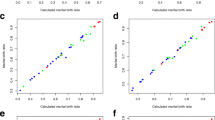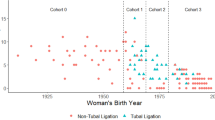Abstract
In this paper I examine the effect of polygyny on aggregate reproductive behavior. I argue that within countries there exist different polygyny regimes, each exhibiting a unique reproductive pattern. Using the 1988/1989 Kenya Demographic and Health Survey (KDHS1) data, I identify three distinct regimes: low-polygyny, mid polygyny, and high-polygyny regimes. The results of the bivariate and multivariate analyses reveal strong differences in reproductive preferences and behaviors across polygyny regimes. High-polygyny regimes, for instance, maintain a value orientation that favors and encourages high reproductive performance. The force of this pronatalism operates equally for men and women; but whereas men in this regime attain their reproductive goals by marrying multiple wives, women attain theirs by maximizing their reproductive capabilities. This maximization occurs through early initiation of sexual/reproductive activity, universal marriage and minimal interruption of marriage, nonuse of contraception within a union, and a positive attitude toward high fertility.
Similar content being viewed by others
References
Ahmed, J. 1986. “Polygyny and Fertility Differentials Among the Yoruba of Western Nigeria.” Journal of Biosocial Science 18(1):63–73.
Arowolo, O. 1981. “Plural Marriage, Fertility and the Problem of Multiple Causation.” Pp. 112–33 in Women’s Education and Modernization of the Family in West Africa, edited by H. Ware. Canberra, Australia: Australian National University, Department of Demography. (Changing African Family Project Series. Monograph No. 7)
Barrett, J.C. 1971. “Fecundability and Coital Frequency.” Population Studies 25(2):309–13.
Bhatia, J.C. 1985. “Polygamy-Fertility Inter-Relationship: The Case of Ghana.” Journal of Family Welfare 31(4):46–55.
Bongaarts, J. and R.G. Potter. 1983. Fertility, Biology, and Behavior: An Analysis of the Proximate Determinants. New York: Academic Press, Inc.
Caldwell, J.C. and P. Caldwell. 1990. “High Fertility in Sub-Saharan Africa.” Scientific American 262(5): 118–25.
Caldwell, P. 1976. “Issues of Marriage and Marital Change: Tropical Africa and the Middle East.” Pp. 325–55 in Family and Marriage in Some African and Asiatic Countries, edited by S.A. Huzayyin and G.T. Acsadi. Cairo, Egypt: Cairo Demographic Centre. (Research Monograph Series No. 6).
Cazès, M.H. 1990. “Endogamy Among the Dogon of Boni, Mali.” Journal of Biosocial Science 22(1):85–99.
Cleland, J. and C. Wilson. 1987. “Demand Theories of the Fertility Transition: An Iconoclastic View.” Population Studies 41(1):5–30.
Coale, A.J. and S.C. Watkins (eds.). 1986. Decline of Fertility in Europe. Princeton: Princeton University Press.
Conte, E. 1979. “Politics and Marriage in South Kanem (Chad): A Statistical Presentation of Endogamy From 1895 to 1975.” Cahiers ORSTOM, Serie Sciences Humaines 16(4):275–97.
Cronk, L. 1991. “Wealth, Status, and Reproductive Success Among the Mukongodo of Kenya.” American Anthropologist 93:345–60.
Emereuwaonu, E.U. 1988. “Population, National Integration and Ethnicity in Nigeria: Problems and Prospects.” Pp. 97–115 in Population and the Nigerian Political System, edited by Population Association of Nigeria. (Population Association of Nigeria Proceedings No. 5).
Frank, O. and G. McNicoll. 1987. “An Interpretation of Fertility and Population Policy in Kenya.” Population and Development Review 13(2):209–43.
Garenne, M. and E. van de Walle E. 1989. “Polygyny and Fertility Among the Sereer of Senegal.” Population Studies 43(2):267–83.
Goldberg, H.I., M. McNeill, and A. Spitz. 1989. “Contraceptive Use and Fertility Decline in Chogoria, Kenya.” Studies in Family Planning 20(1): 17–25.
Government of Kenya and United Nations Children’s Fund (UNICEF). 1989. Situation Analysis of Children and Women in Kenya. Nairobi, Kenya: UNICEF Kenya Country Office.
Handwerker, W.P. 1986. “Natural Fertility as a Balance of Choice and Behavioral Effect: Policy Implications for Liberian Farm Households.” Pp. 90–111 in Culture and Reproduction: An Anthropological Critique of Demographic Transition Theory, edited by W.P. Handwerker. Boulder, Colorado: Westview Press.
Irons, W. 1979. “Cultural and Biological Success.” Pp. 257–72 in Evolutionary Biology and Human Social Behavior: an Anthropological Perspective, edited by N.A. Chagnon and W. Irons. North Scituate, MA: Duxbury.
Iversen, G.R. 1991. Contextual Analysis. Sage University Papers Series on Quantitative Applications in the Social Sciences, 07-081. Newbury Park, CA: Sage.
Karanja, W.W. 1994. “The Phenomenon of Outside Wives: Some Reflections on its Possible Influence on Fertility.” Pp. 194–214 in Nuptiality in Sub-Sahara Africa: Contemporary Anthropological and Demographic Perspectives, edited by C. Bledsoe and G. Pison. Oxford: Clarendon Press.
Kelly, H.A. 1992. From Gada to Islam: The Moral Authority of Gender Relations Among the Pastoral Orma of Kenya. Ann Arbor, Michigan: University Microfilms International.
Kenya Central Bureau of Statistics. 1980. Kenya Fertility Survey, 1977–1978. Nairobi: Ministry of Finance and Planning.
— 1984. Kenya Contraceptive Prevalence Survey 1984. First Report. Nairobi, Kenya: Ministry of Finance and Planning.
Lesthaeghe, R. 1978. The Decline of Belgian Fertility, 1800–1960. Princeton: Princeton University Press.
Macro International, Inc. 1993. An Assessment of the Quality of Health Data in DHS-I Surveys. DHS Methodological Reports, No. 2. Calverton, MD: Macro International, Inc.
Makoteku, O.J. and A.B. Ocholla-Ayayo. 1988. “Marriage Patterns in Kenya and Their Inter-Relation With Fertility.” Pp. 61–72 in African Population Conférence/Congres Africain de Population, Dakar, Senegal, November 7–12, 1988:5.1. Liege, Belgium: IUSSP.
Mann, K. 1994. “The Impact of Christianity on Yoruba Marriage, Gender, and Fertility.” Pp. 167–93 in Nuptiality in Sub-Saharan Africa: Contemporary Anthropological and Demographic Perspectives, edited by C. Bledsoe and G. Pison. Oxford: Clarendon Press.
Mason, W.M., G.W. Wong, and B. Entwisle. 1983. “Contextual Analysis Through the Multilevel Linear Model.” Pp. 72–103 in Sociological Methodology 1983–1984, edited by S. Leinhardt. San Francisco: Jossey-Bass.
Muhuri, P.K. and S.O. Rutstein. 1994. Socioeconomic, Demographic, and Health Indicators for Subnational Areas. DHS Comparative Studies No. 9. Calverton, MD: Macro International, Inc.
Mulder, M.B. 1989. “Marital Status and Reproductive Performance in Kipsigis Women: Re-evaluating the Polygyny-Fertility Hypothesis.” Population Studies 43(2):285–304.
— 1990. “Kipsigis Women’s Preferences for Wealthy Men: Evidence for Female Choice in Mammals?” Behavioral Ecology and Sociobiology 27(4):255–64.
Musham, H.V. 1956. “Fertility of Polygamous Marriages.” Population Studies 10(1):3–16.
National Council for Population and Development and The Institute for Resource Development. 1989. Kenya Demographic and Health Survey 1989. Columbia, MD: Institute for Resource Development.
National Council for Population and Development (NCPD), Central Bureau of Statistics (Office of the Vice President and Ministry of Planning and National Development [Kenya]; CBS), and Macro International, Inc. (MI). 1994. Kenya Demographic and Health Survey 1993. Calverton, MD: NCPD, CBS, and MI.
Njogu, W. 1991. “Trends and Determinants of Contraceptive Use in Kenya.” Demography 28:83–99.
Obbo, C. 1987. “The Old and New in East African Elite Marriages.” Pp. 263–80 in Transformations of African Marriage, edited by D. Parkin and D. Nyamwaya. Manchester: Manchester University Press.
Ominde, S.H. 1974. “Demography and Ethnic Groups.” Pp. 27–48 in Health and Disease in Kenya, edited by L.C. Vogel, et al. Nairobi, Kenya: East African Literature Bureau.
Pebley, A.R. and W. Mbugua. 1989. “Polygyny and Fertility in Sub-Saharan Africa.” Pp. 338–64 in Reproduction and Social Organization in Sub-Saharan Africa, edited by R.J. Lesthaeghe. Berkeley: University of California Press.
Pison, G. 1986. “A Demographic Study of Polygyny.” Population 41(1):93–122.
— 1987. “Polygyny, Fertility and Kinship in a Region of Sub-Saharan Africa.” Pp. 16–27 in The Cultural Roots of African Fertility Regimes, Proceedings of the Ife Conference, February 25-March 1, 1987, sponsored by the Department of Demography and Social Statistics, Obafemi Awolowo University (formerly University of Ife), and the Population Studies Center, University of Pennsylvania. Philadelphia: University of Pennsylvania, Population Studies Center.
Pritchett, L.H. 1994. “Desired Fertility and the Impact of Population Policies.” Population and Development Review 20(1): 1–55.
Rubin, D.S. 1990. “Women’s Work and Children’s Nutrition in South-Western Kenya.” Food and Nutrition Bulletin 12(4):268–72.
Sichona, F.J. 1992. “The Polygyny-Fertility Hypothesis Revisited: The Situation in Ghana.” Carolina Population Center, Paper No. 92-01, University of North Carolina at Chapel Hill.
— 1993. “The Polygyny-Fertility Hypothesis Revisited: The Situation in Ghana.” Journal of Biosocial Science 25(4):473–82.
Speizer, I. 1995. “New Approaches to Men and Marriage in Francophone Africa.” Paper presented at the 1995 Annual Meetings of the Population Association of America, San Francisco.
Udo, R.K. 1979. “Population and Politics in Sub-Saharan Africa.” Pp. 172–81 in Population Education Source Book for sub-Saharan Africa, edited by R.K. Udo. Nairobi, Kenya: Heinemann Educational Books.
Watkins, S.C. 1986. “Conclusions.” Pp. 420–49 in The Decline of Fertility in Europe, edited by A.J. Coale and S.C. Watkins. Princeton: Princeton University Press.
Author information
Authors and Affiliations
Corresponding author
Rights and permissions
About this article
Cite this article
Ezeh, A.C. Polygyny and reproductive behavior in sub-saharan Africa: A contextual analysis. Demography 34, 355–368 (1997). https://doi.org/10.2307/3038289
Issue Date:
DOI: https://doi.org/10.2307/3038289




